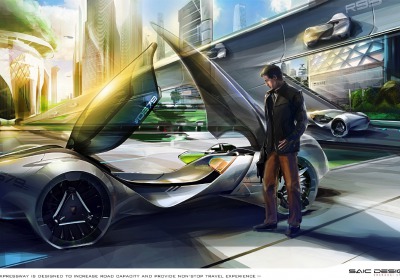SAIC's Mobiliant wins 2013 LA Design Challenge
Mon, 25 Nov 2013SAIC has been revealed as the winner of this year's LA Design Challenge.
The Chinese carmaker's entry, a single-seat urban public transit vehicle, was declared the victor after intense judging sessions took place throughout the LA auto show's second press day. The panel – which included Tom Matano, executive director, School of Industrial Design at San Francisco's Academy of Art University, and Stewart Reed, chair of Transportation Design at Pasadena's Art Center College of Design – combed through the entries, discussing their merits and how closely they fit the brief, before hearing the teams' presentations in the afternoon.
Nine top global design studios – Toyota, Subaru, two groups from BMW DesignworksUSA, Mazda, Changfeng, Qoros, JAC, and SAIC – submitted entries for the annual contest.
Themed ‘Biomimicry & Mobility 2025: Nature's Answer to Human Challenges', the brief called for designs for a vehicle experience that mimics nature to solve problems like congestion, pollution, sustainability and safety.
SAIC's team – consisting of global design director Anthony Williams-Kenny, China design director Shao Jingfeng and the design team of Xu Dengtao, Ling Yuzhou, Ji Zhiheng, Niu Wenbo, Zhang Mingxi and Qian Junlin – imagined a vehicle to help improve transportation and operational efficiency for future urban ecologies. Mobiliant was inspired by an ant's body structure and the mutually beneficial relationship between ants and trumpet trees.
How it worksMobiliant's translucent cover works in the same way as the tiny valves – or spiracles – in an ant's exoskeleton, capturing air pollutants and greenhouse gases through tiny tunnels while an inner enzyme-driven transformer reduces them to liquid products for use as fertilizer. There's one container on each side – on the left side, a green container stores biofuel from the fermentation of Ecobuilding plants, while the right side's brown container stores collected fertilizer.
The Cilium Layer Advanced Wheel System (CLAWS), together with a dual rotation system separating its body into three active parts, enables Mobiliant to adapt to different road conditions and gives extra grip. Inside, a stabilizer counteracts the effect of G-force.
A new kind of 3D road network called the Mobiliant Expressway would maximize Mobiliant's features, with three distinctive infrastructure designs for a smooth, non-stop personal transit experience. These are: different levels for increased road capacity, helping decongestion; non-stop intersections with no traffic lights and intersection delays; and direct connection to buildings.
This network doesn't only serve as a means of transportation but also as an important part in the urban ecology cycle. With the transportation network combining with the urban ecology, a new urban concept called the Mutualistic Ecological City is formed. The idea comes from the mutually beneficial relationship between ants and trumpet trees, with Ecobuildings playing the role of the trumpet trees. Its main appeal is its ability to capture and break down pollutants, helping restore and improve the urban environment.
Congratulations to SAIC, who has won the competition upon its first year of entry.
By Ryan Borroff

